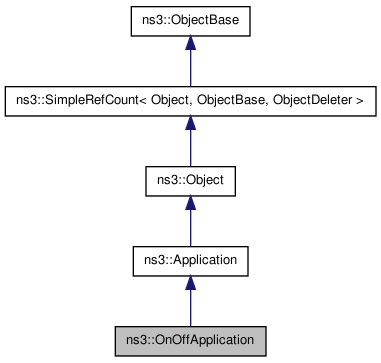Generate traffic to a single destination according to an OnOff pattern. More...
#include <onoff-application.h>


Public Member Functions | |
| void | SetMaxBytes (uint32_t maxBytes) |
Static Public Member Functions | |
| static TypeId | GetTypeId (void) |
| This method returns the TypeId associated to ns3::OnOffApplication. | |
Protected Member Functions | |
| virtual void | DoDispose (void) |
Detailed Description
Generate traffic to a single destination according to an OnOff pattern.
This traffic generator follows an On/Off pattern: after Application::StartApplication is called, "On" and "Off" states alternate. The duration of each of these states is determined with the onTime and the offTime random variables. During the "Off" state, no traffic is generated. During the "On" state, cbr traffic is generated. This cbr traffic is characterized by the specified "data rate" and "packet size".
Note: When an application is started, the first packet transmission occurs _after_ a delay equal to (packet size/bit rate). Note also, when an application transitions into an off state in between packet transmissions, the remaining time until when the next transmission would have occurred is cached and is used when the application starts up again. Example: packet size = 1000 bits, bit rate = 500 bits/sec. If the application is started at time 3 seconds, the first packet transmission will be scheduled for time 5 seconds (3 + 1000/500) and subsequent transmissions at 2 second intervals. If the above application were instead stopped at time 4 seconds, and restarted at time 5.5 seconds, then the first packet would be sent at time 6.5 seconds, because when it was stopped at 4 seconds, there was only 1 second remaining until the originally scheduled transmission, and this time remaining information is cached and used to schedule the next transmission upon restarting.
If the underlying socket type supports broadcast, this application will automatically enable the SetAllowBroadcast(true) socket option.
Member Function Documentation
| virtual void ns3::OnOffApplication::DoDispose | ( | void | ) | [protected, virtual] |
This method is called by Object::Dispose or by the object's destructor, whichever comes first.
Subclasses are expected to implement their real destruction code in an overriden version of this method and chain up to their parent's implementation once they are done. i.e., for simplicity, the destructor of every subclass should be empty and its content should be moved to the associated DoDispose method.
It is safe to call GetObject from within this method.
Reimplemented from ns3::Application.
| static TypeId ns3::OnOffApplication::GetTypeId | ( | void | ) | [static] |
This method returns the TypeId associated to ns3::OnOffApplication.
This object is accessible through the following paths with Config::Set and Config::Connect:
- /NodeList/[i]/ApplicationList/[i]/$ns3::OnOffApplication
- /NodeList/[i]/DeviceList/[i]/$ns3::AlohaNoackNetDevice/Phy/$ns3::Application/$ns3::OnOffApplication
- /NodeList/[i]/DeviceList/[i]/$ns3::AlohaNoackNetDevice/Phy/$ns3::OnOffApplication
- /NodeList/[i]/DeviceList/[i]/$ns3::BaseStationNetDevice/BsIpcsPacketClassifier/$ns3::Application/$ns3::OnOffApplication
- /NodeList/[i]/DeviceList/[i]/$ns3::BaseStationNetDevice/BsIpcsPacketClassifier/$ns3::OnOffApplication
- /NodeList/[i]/DeviceList/[i]/$ns3::BaseStationNetDevice/LinkManager/$ns3::Application/$ns3::OnOffApplication
- /NodeList/[i]/DeviceList/[i]/$ns3::BaseStationNetDevice/LinkManager/$ns3::OnOffApplication
- /NodeList/[i]/DeviceList/[i]/$ns3::BaseStationNetDevice/SSManager/$ns3::Application/$ns3::OnOffApplication
- /NodeList/[i]/DeviceList/[i]/$ns3::BaseStationNetDevice/SSManager/$ns3::OnOffApplication
- /NodeList/[i]/DeviceList/[i]/$ns3::BaseStationNetDevice/ServiceFlowManager/$ns3::Application/$ns3::OnOffApplication
- /NodeList/[i]/DeviceList/[i]/$ns3::BaseStationNetDevice/ServiceFlowManager/$ns3::OnOffApplication
- /NodeList/[i]/DeviceList/[i]/$ns3::NonCommunicatingNetDevice/Phy/$ns3::Application/$ns3::OnOffApplication
- /NodeList/[i]/DeviceList/[i]/$ns3::NonCommunicatingNetDevice/Phy/$ns3::OnOffApplication
- /NodeList/[i]/DeviceList/[i]/$ns3::SubscriberStationNetDevice/Classifier/$ns3::Application/$ns3::OnOffApplication
- /NodeList/[i]/DeviceList/[i]/$ns3::SubscriberStationNetDevice/Classifier/$ns3::OnOffApplication
- /NodeList/[i]/DeviceList/[i]/$ns3::SubscriberStationNetDevice/LinkManager/$ns3::Application/$ns3::OnOffApplication
- /NodeList/[i]/DeviceList/[i]/$ns3::SubscriberStationNetDevice/LinkManager/$ns3::OnOffApplication
- /NodeList/[i]/DeviceList/[i]/$ns3::SubscriberStationNetDevice/SSScheduler/$ns3::Application/$ns3::OnOffApplication
- /NodeList/[i]/DeviceList/[i]/$ns3::SubscriberStationNetDevice/SSScheduler/$ns3::OnOffApplication
- /NodeList/[i]/DeviceList/[i]/$ns3::UanNetDevice/Channel/NoiseModel/$ns3::Application/$ns3::OnOffApplication
- /NodeList/[i]/DeviceList/[i]/$ns3::UanNetDevice/Channel/NoiseModel/$ns3::OnOffApplication
- /NodeList/[i]/DeviceList/[i]/$ns3::UanNetDevice/Channel/PropagationModel/$ns3::Application/$ns3::OnOffApplication
- /NodeList/[i]/DeviceList/[i]/$ns3::UanNetDevice/Channel/PropagationModel/$ns3::OnOffApplication
- /NodeList/[i]/DeviceList/[i]/$ns3::UanNetDevice/Mac/$ns3::Application/$ns3::OnOffApplication
- /NodeList/[i]/DeviceList/[i]/$ns3::UanNetDevice/Mac/$ns3::OnOffApplication
- /NodeList/[i]/DeviceList/[i]/$ns3::UanNetDevice/Phy/$ns3::Application/$ns3::OnOffApplication
- /NodeList/[i]/DeviceList/[i]/$ns3::UanNetDevice/Phy/$ns3::OnOffApplication
- /NodeList/[i]/DeviceList/[i]/$ns3::UanNetDevice/Transducer/$ns3::Application/$ns3::OnOffApplication
- /NodeList/[i]/DeviceList/[i]/$ns3::UanNetDevice/Transducer/$ns3::OnOffApplication
- /NodeList/[i]/DeviceList/[i]/$ns3::WimaxNetDevice/$ns3::BaseStationNetDevice/BsIpcsPacketClassifier/$ns3::Application/$ns3::OnOffApplication
- /NodeList/[i]/DeviceList/[i]/$ns3::WimaxNetDevice/$ns3::BaseStationNetDevice/BsIpcsPacketClassifier/$ns3::OnOffApplication
- /NodeList/[i]/DeviceList/[i]/$ns3::WimaxNetDevice/$ns3::BaseStationNetDevice/LinkManager/$ns3::Application/$ns3::OnOffApplication
- /NodeList/[i]/DeviceList/[i]/$ns3::WimaxNetDevice/$ns3::BaseStationNetDevice/LinkManager/$ns3::OnOffApplication
- /NodeList/[i]/DeviceList/[i]/$ns3::WimaxNetDevice/$ns3::BaseStationNetDevice/SSManager/$ns3::Application/$ns3::OnOffApplication
- /NodeList/[i]/DeviceList/[i]/$ns3::WimaxNetDevice/$ns3::BaseStationNetDevice/SSManager/$ns3::OnOffApplication
- /NodeList/[i]/DeviceList/[i]/$ns3::WimaxNetDevice/$ns3::BaseStationNetDevice/ServiceFlowManager/$ns3::Application/$ns3::OnOffApplication
- /NodeList/[i]/DeviceList/[i]/$ns3::WimaxNetDevice/$ns3::BaseStationNetDevice/ServiceFlowManager/$ns3::OnOffApplication
- /NodeList/[i]/DeviceList/[i]/$ns3::WimaxNetDevice/$ns3::SubscriberStationNetDevice/Classifier/$ns3::Application/$ns3::OnOffApplication
- /NodeList/[i]/DeviceList/[i]/$ns3::WimaxNetDevice/$ns3::SubscriberStationNetDevice/Classifier/$ns3::OnOffApplication
- /NodeList/[i]/DeviceList/[i]/$ns3::WimaxNetDevice/$ns3::SubscriberStationNetDevice/LinkManager/$ns3::Application/$ns3::OnOffApplication
- /NodeList/[i]/DeviceList/[i]/$ns3::WimaxNetDevice/$ns3::SubscriberStationNetDevice/LinkManager/$ns3::OnOffApplication
- /NodeList/[i]/DeviceList/[i]/$ns3::WimaxNetDevice/$ns3::SubscriberStationNetDevice/SSScheduler/$ns3::Application/$ns3::OnOffApplication
- /NodeList/[i]/DeviceList/[i]/$ns3::WimaxNetDevice/$ns3::SubscriberStationNetDevice/SSScheduler/$ns3::OnOffApplication
- /NodeList/[i]/DeviceList/[i]/$ns3::WimaxNetDevice/BandwidthManager/$ns3::Application/$ns3::OnOffApplication
- /NodeList/[i]/DeviceList/[i]/$ns3::WimaxNetDevice/BandwidthManager/$ns3::OnOffApplication
- /NodeList/[i]/DeviceList/[i]/$ns3::WimaxNetDevice/BurstProfileManager/$ns3::Application/$ns3::OnOffApplication
- /NodeList/[i]/DeviceList/[i]/$ns3::WimaxNetDevice/BurstProfileManager/$ns3::OnOffApplication
- /NodeList/[i]/DeviceList/[i]/$ns3::WimaxNetDevice/Channel/$ns3::UanChannel/NoiseModel/$ns3::Application/$ns3::OnOffApplication
- /NodeList/[i]/DeviceList/[i]/$ns3::WimaxNetDevice/Channel/$ns3::UanChannel/NoiseModel/$ns3::OnOffApplication
- /NodeList/[i]/DeviceList/[i]/$ns3::WimaxNetDevice/Channel/$ns3::UanChannel/PropagationModel/$ns3::Application/$ns3::OnOffApplication
- /NodeList/[i]/DeviceList/[i]/$ns3::WimaxNetDevice/Channel/$ns3::UanChannel/PropagationModel/$ns3::OnOffApplication
- /NodeList/[i]/DeviceList/[i]/$ns3::WimaxNetDevice/ConnectionManager/$ns3::Application/$ns3::OnOffApplication
- /NodeList/[i]/DeviceList/[i]/$ns3::WimaxNetDevice/ConnectionManager/$ns3::OnOffApplication
- /NodeList/[i]/DeviceList/[i]/$ns3::WimaxNetDevice/Phy/Channel/$ns3::UanChannel/NoiseModel/$ns3::Application/$ns3::OnOffApplication
- /NodeList/[i]/DeviceList/[i]/$ns3::WimaxNetDevice/Phy/Channel/$ns3::UanChannel/NoiseModel/$ns3::OnOffApplication
- /NodeList/[i]/DeviceList/[i]/$ns3::WimaxNetDevice/Phy/Channel/$ns3::UanChannel/PropagationModel/$ns3::Application/$ns3::OnOffApplication
- /NodeList/[i]/DeviceList/[i]/$ns3::WimaxNetDevice/Phy/Channel/$ns3::UanChannel/PropagationModel/$ns3::OnOffApplication
Attributes defined for this type:
-
DataRate: The data rate in on state.
- Set with class: DataRateValue
- Underlying type: DataRate
- Initial value: 500000bps
- Flags: construct write read
-
PacketSize: The size of packets sent in on state
- Set with class: ns3::UintegerValue
- Underlying type: uint32_t 1:4294967295
- Initial value: 512
- Flags: construct write read
-
Remote: The address of the destination
- Set with class: AddressValue
- Underlying type: Address
- Initial value: 00-00-00
- Flags: construct write read
-
OnTime: A RandomVariable used to pick the duration of the 'On' state.
- Set with class: RandomVariableValue
- Underlying type: RandomVariable
- Initial value: Constant:1
- Flags: construct write read
-
OffTime: A RandomVariable used to pick the duration of the 'Off' state.
- Set with class: RandomVariableValue
- Underlying type: RandomVariable
- Initial value: Constant:1
- Flags: construct write read
-
MaxBytes: The total number of bytes to send. Once these bytes are sent, no packet is sent again, even in on state. The value zero means that there is no limit.
- Set with class: ns3::UintegerValue
- Underlying type: uint32_t 0:4294967295
- Initial value: 0
- Flags: construct write read
-
Protocol: The type of protocol to use.
- Set with class: TypeIdValue
- Underlying type: TypeId
- Initial value: ns3::UdpSocketFactory
- Flags: construct write read
Attributes defined in parent class ns3::Application:
- StartTime: Time at which the application will start
- StopTime: Time at which the application will stop
TraceSources defined for this type:
- Tx: A new packet is created and is sent
Reimplemented from ns3::Application.
| void ns3::OnOffApplication::SetMaxBytes | ( | uint32_t | maxBytes | ) |
- Parameters:
-
maxBytes the total number of bytes to send
Set the total number of bytes to send. Once these bytes are sent, no packet is sent again, even in on state. The value zero means that there is no limit.
The documentation for this class was generated from the following files:
- src/applications/onoff/onoff-application.h
- doc/introspected-doxygen.h
 1.7.1
1.7.1